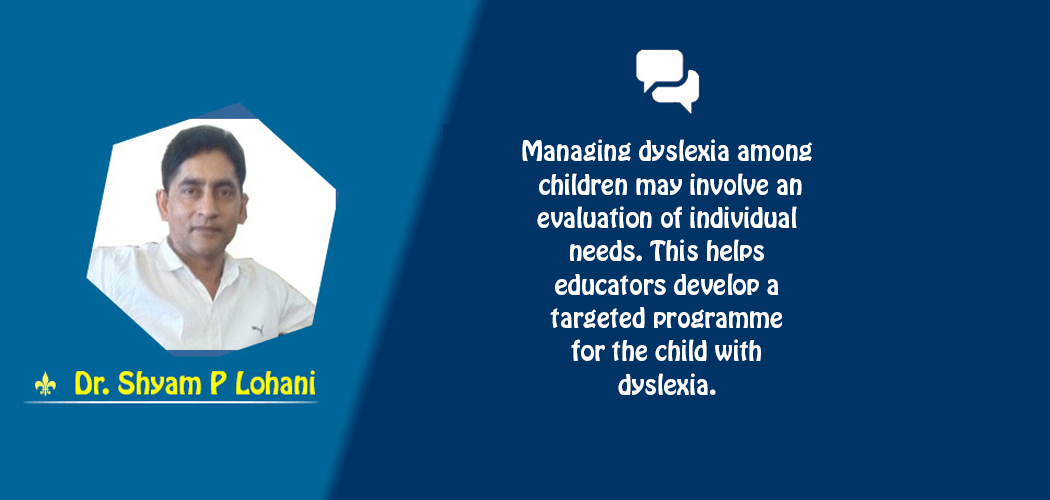- Wednesday, 24 December 2025
Need Of Managing Dyslexia
Dr. Shyam P Lohani
Learning abilities vary among different persons. However, studies have shown that there are certain percentages of people for whom learning is difficult. Dyslexia, one of the learning disabilities, is often found among people. It is associated with graphic symbols and the sounds of words to the brain. Dyslexic people find difficulty recognising word and spelling, and do not have an ability to match letters to sounds for no apparent reason. However, such persons may be intelligent and able to achieve well in other areas. They are exposed to the same education as others but are unable to read at the expected level.
Common problem
Dyslexia is commonly found worldwide. An estimated 5-10 per cent of people have dyslexia; on the other hand, some studies have projected that the prevalence rate is 17 per cent. The effects of dyslexia vary from person to person. People having this condition generally have trouble reading quickly and without making mistakes. They may also have difficulty understanding the text. People can show symptoms of dyslexia at any age, often they tend to appear during childhood.
It has been seen that dyslexic people often have a natural talent for arts such as music, dance, drawing, or acting. Usually, they possess the unique capability to see patterns in noise that helps them to produce mundane into something more interesting and exciting. It runs in families. Therefore, it is linked to genes. People are more likely to have dyslexia if their parents, siblings, or other family members have it. The condition usually stems from differences in parts of the brain that process language. Dyslexia can cause challenges that involve reaching development milestones as such children with dyslexia may learn to crawl, walk, talk, and ride a bicycle later than their peers.
A child with dyslexia often takes a longer time to learn to speak than a normal child. S/he may also mispronounce words, find rhyming challenging, and appear not to distinguish between different words’ sounds. Such often find learning difficult. This difficulty can present as early as preschool. They face difficulty matching letters to sounds, and recognising sounds in words.
Dyslexia symptoms start showing their effects when young people start learning more complex skills. The condition can cause difficulty with grammar, reading comprehension, reading fluency, sentence structure, and in-depth writing. Some children with dyslexia usually not follow expected patterns of learning progression. As an example, they may learn to spell a word and completely forget it the next day. Another aspect of dyslexia is processing sound. A word which has more than two syllables, processing the sounds can become much more challenging for dyslexic people.
Children with dyslexia may take a long time to learn the letters of the alphabet than their siblings and friends and have difficulty in pronunciation of words. They may also have problem with remembering the days of the week, months of the year, colours, and arithmetic tables. There seems a coordination issue with dyslexic individuals in comparison to their peers. Catching a ball may be difficult, and they may often confuse left and right. However, reduced hand-eye coordination can also be a symptom of other neurological conditions such as dyspraxia. A person with dyslexia may express ideas in a sequence that seems illogical or unconnected to their peers.
People with dyslexia have trouble with concentration. The reason behind this is that after a few minutes of struggling to read or write, they may feel mentally exhausted. In comparison to the general population, children with dyslexia also have attention deficit hyperactivity disorder (ADHD) in higher proportion. It has been estimated that 30 per cent of those with dyslexia also have ADHD, compared with 3–5 per cent of the general school population experiencing both conditions.
No cure
There is no cure for dyslexia, but the person can benefit from specialised support and different approaches to help their daily tasks much easier. Supports could include individual tutoring from a specialist educator, a phonics-based reading programme that teaches the link between spoken and written sounds, and a multi-sensory approach to learning using as many different senses at time as possible such as audio-visual, performing, and speaking. They may need specialised arrangements such as taking oral instead of written tests and learning via audio or video recordings.
A right diagnosis and support early in life can have long-term benefits. Managing dyslexia among children may involve an evaluation of individual needs. This helps educators develop a targeted programme for the child with dyslexia. In Nepal, there are very few specialised centres for guiding and helping those who are unable to achieve learning goals. Hence, it is called upon the government and other stakeholders to initiate establishments for those people. Similarly, teachers and therapists are needed for running such institutions. Thus, the investment in manpower development is the need of the present time.
(Dr. Lohani is the clinical director at the Nepal drug and Poison Information Centre. lohanis@gmail.com)

















